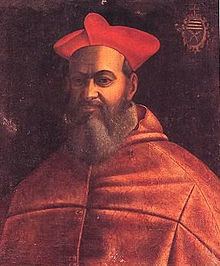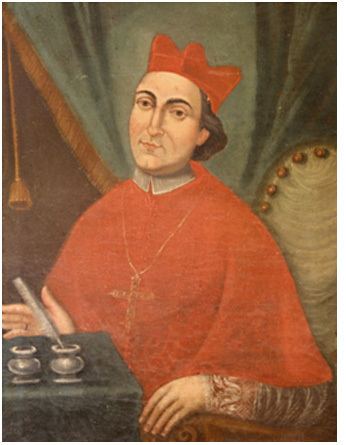Term ended 23 July 1577 Name Scipione Rebiba Appointed May 5, 1574 Denomination Roman Catholic Consecration May 14, 1541 | Birth name Scipione Rebiba Predecessor Giovanni Ricci Rank Cardinal-Bishop Successor Giacomo Savelli | |
 | ||
Born 3 February 1504San Marco d’Alunzio ( 1504-02-03 ) Previous post Auxiliary Bishop of Chieti (1541 – 1551)Titular Bishop of Amyclae (1541 – 1551)Bishop of Mottola (1551 – 1556)Cardinal-Priest of S. Pudenziana (1556 – 1565)Archbishop of Pisa (1556 – 1560)Archbishop of Troia (1560)Cardinal-Priest of S. Anastasia (1565 – 1566)Titular Patriarch of Constantinople (1565 – 1573)Cardinal-Priest of S. Angelo in Pescheria (1566 – 1570)Cardinal-Priest of S. Maria in Trastevere (1570 – 1573)Cardinal-Bishop of Albano (1573 – 1574) Died July 23, 1577, Rome, Italy | ||
Created cardinal December 20, 1555 | ||
SUCESIÓN APOSTÓLICA DE FRAY GUSTAVO DE JESÚS.
Scipione Rebiba (3 February 1504 – 23 July 1577) was an Italian cardinal of the Roman Catholic Church.
Contents

He is of particular ecclesiastical significance since more than 95% of all living Catholic bishops trace their episcopal lineage back to him.
Biography
Scipione Rebiba was born in the village (borgo, vico) of San Marco d'Alunzio, in Sicily. He studied in Palermo, enjoying a benefice in the Church of S. Maria dei Miracoli.
He was appointed titular Bishop of Amyclae (a suffragan of Patras in the Peloponnesus) by Pope Paul III on 16 March 1541, on the recommendation of Bishop Gian Pietro Carafa, so that he could serve as Carafa's auxiliary bishop in the diocese of Chieti.
On February 22, 1549, Cardinal Carafa was named by Pope Paul III to be Archbishop of Naples, but the opposition of the Emperor Charles V prevented him from taking possession of his see until July 1551. Cardinal Carafa, who was active in Rome as one of the six cardinals of the Roman Inquisition (1542-1555), nonetheless retained possession of the See of Naples, and in 1551 appointed his friend Scipio Rebiba as his Vicar to administer the diocese on his behalf. Rebiba was also promoted in the episcopacy to the see of Motula on 12 October 1551. He was thus a bishop of a See in the Kingdom of Naples. With the full support of the head of the Inquisition in Rome, Rebiba introduced the Roman Inquisition into Naples and was granted the office of Commissary of the Roman Inquisition.
Rebiba was immediately appointed Governor of Rome (5 July 1555) after his patron, Gian Paolo Carafa, was elected pope on 23 May 1555. He served only a few months, until the next Consistory for the elevation of cardinals.
Rebiba was created a cardinal during the consistory of 20 December 1555. He was assigned the Church of S. Pudenziana, which he held from 24 January 1556 until February 7, 1565, when he was translated to the Church of S. Anastasia. These translations had to do with the prestige of a particular church as well as with its disposable income.
Rebiba was appointed Archbishop of Pisa by Paul IV on 13 April 1556 and took possession of that metropolitan see on 29 April 1556, through a procurator.
In the consistory of 9 April 1556, just before he was appointed Archbishop of Pisa, Rebiba was named legate before King Philip II in Brussels to congratulate him for the short-lived Treaty of Vaucelles with King Henry II of France. He received the legatine cross on 11 May 1556 and left Rome for Brussels on 30 May 1556. However, while he was traveling, relations with Spain worsened and the legation was revoked. He returned to Rome in September 1556,]]. after Philip II decided to declare war against Pope Paul IV and start occupying territory of the Papal States, an act which, according to Philip II, was for the benefit of the Church.
In a letter to the Princess Dowager of Portugal, Regent of Spain, dated 22 September 1556, Francisco de Vargas wrote:
"I have reported to your Highness what has been happening here, and how far the Pope is going in his fury and vain imaginings. His Majesty could not do otherwise than have a care for his reputation and dominions. I am sure your Highness will have had more recent news from the Duke of Alva, who has taken the field with an excellent army and has penetrated so far into the Pope's territory that his cavalry is raiding up to ten miles from Rome, where there is such panic that the population would have run away had not the gates been closed. The Pope has fallen ill with rage, and was struggling with a fever on the 16th of this month. The two Carafa brothers, the Cardinal and Count Montorio, do not agree, and they and Piero Strozzi are not on as good terms as they were in the past. They would like to discuss peace. The best thing would be for the Pope to die, for he is the poison at the root of all this trouble and more which may occur. His Majesty's intention is only to wrest the knife from this madman's hand and make him return to a sense of his dignity, acting like the protector of the Apostolic See, in whose name, and that of the College of Cardinals, his Majesty has publicly proclaimed that he has seized all he is occupying. The Pope is now sending again to the potentates of Italy for help. I hope he will gain as little thereby as he has done in the past, and that the French will calm down. May God give us peace in the end, as their Majesties desire and deserve!"
Rebiba was one of seven cardinals named to a commission charged with preparing a peace agreement. The efforts were later abandoned by a decision of Paul IV, and the war continued. On 27 August 1557, Fernando Alvarez de Toledo, Duke of Alba and Viceroy of Naples, was at the walls of Rome, ready to lead his troops for a final assault. On 13 September 1557, Cardinal Carlo Carafa, the Pope's nephew and principal minister, signed a peace agreement, accepting all of the duke's conditions.
In 1557, Cardinal Giovanni Morone had been arrested on orders of Paul IV, and imprisoned in the Castel S. Angelo. A long list of charges was put together, but the principal ones were heresy and dealing with Lutherans. Paul IV appointed a committee of Cardinals to examine the prisoner, Cardinals Ghislieri [Alessandrino] (the future Pius IV), Scipione Rebiba, Jean Suau de Rieumes, and Alessandro Farnese. The Committee cleared Cardinal Morone of all the charges. Nonetheless, Paul IV, who had been the Inquisitor General when the charges were being compiled, issued a bull, refusing to accept the findings of his own commission, and Cardinal Morone was kept in prison in the Castel S. Angelo, under suspicion of the Pope personally. When Paul IV died, the innocent Cardinal was still in the Castel S. Angelo. His release was ordered by the College of Cardinals at their first Congregation during the Sede Vacante of 1559.
In 1559, after the death of Paul IV (Carafa), the new Pope, Pius IV, authorized a number of arrests of persons accused of various crimes during the administration of Paul IV. Among them were Cardinal Carlo Carafa, the Nephew of Paul IV, and Cardinal Scipione Rebiba. They were sent to the Castel S. Angelo and imprisoned. Cardinal Rebiba was eventually released. Cardinal Carafa was strangled, on orders of Pius IV, on 4 March 1561.
On 7 October 1566, Rebiba opted for the Church of S. Angelo in Pescheria, but, since the church had the rank of a Deaconry, it was temporarily raised to the rank of a titulus of a cardinal priest for his benefit. He continued to administer that church until 3 July 1570, when he opted for the titulus of Santa Maria in Trastevere.
Cardinal Rebiba participated in the Conclave of 1565-1566, after the death of Pius IV (Giovanni Angelo de' Medici), which elected Cardinal Michael Ghislieri as Pius V. He also voted in the Conclave of 1572, held upon the death of Pius V, which elected Gregory XIII (Ugo Boncompagni).
Rebiba was appointed Bishop of Albano on 8 April 1573, and Bishop of Sabina in 1574.
Cardinal Scipione Rebiba died in Rome on 23 July 1577, and was interred in the Church of S. Silvestro on the Quirinal. His memorial monument lauds him as HAERETICAE PRAVITATIS INQUISITORI SUMMO FIDEI ORTHODOXAE ACERRIMO PROPUGNATORI ('Inquisitor into heretical depravity, a most fierce fighter for the orthodox faith').
Episcopal succession
In the early 18th century, Pope Benedict XIII, whose holy orders were descended from Rebiba, personally consecrated at least 139 bishops for various important European sees, including German, French, English and New World bishops. These bishops in turn consecrated bishops almost exclusively for their respective countries.
Today, more than 95% of the New World's and more than 5,200 Catholic bishops alive today, including Pope Francis, trace their episcopal lineage back to Rebiba. However, no one is sure who consecrated him because no supporting documentation has been found. It has been speculated the records pertaining to his episcopal consecration and those immediately preceding him in office were destroyed in a fire in Chieti, the village north of Rome where Rebiba first became Auxiliary Bishop. Therefore, "it simply means that the details of that bishop's episcopal ordination have not yet been found and that the bishop in question is the last known bishop in that lineage."
